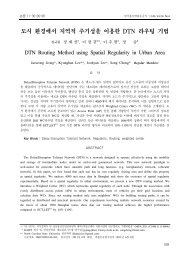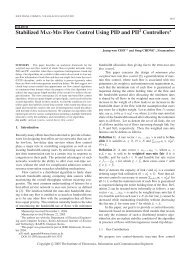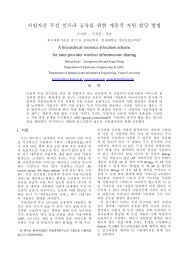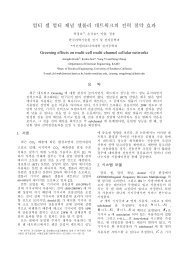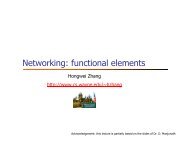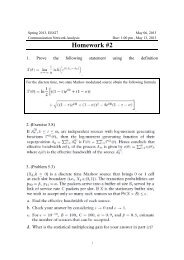Stream Sessions: Stochastic Analysis - Network Systems Laboratory
Stream Sessions: Stochastic Analysis - Network Systems Laboratory
Stream Sessions: Stochastic Analysis - Network Systems Laboratory
Create successful ePaper yourself
Turn your PDF publications into a flip-book with our unique Google optimized e-Paper software.
<strong>Stream</strong> <strong>Sessions</strong>: <strong>Stochastic</strong> <strong>Analysis</strong><br />
Hongwei Zhang<br />
http://www.cs.wayne.edu/~hzhang<br />
Acknowledgement: this lecture is partially based on the slides of Dr. D. Manjunath and Dr. Kumar
Outline<br />
Loose bounds by deterministic calculus<br />
<strong>Stochastic</strong> traffic models<br />
Performance measures<br />
Little’s Theorem, Brumelle’s Theorem, and applications<br />
Multiplexer analysis with stationary and ergodic traffic<br />
Effective bandwidth approach to admission control<br />
Applications to packet voice example<br />
<strong>Stochastic</strong> analysis with shaped traffic<br />
Multihop networks<br />
Long-range-dependent traffic
Outline<br />
Loose bounds by deterministic calculus<br />
<strong>Stochastic</strong> traffic models<br />
Performance measures<br />
Little’s Theorem, Brumelle’s Theorem, and applications<br />
Multiplexer analysis with stationary and ergodic traffic<br />
Effective bandwidth approach to admission control<br />
Applications to packet voice example<br />
<strong>Stochastic</strong> analysis with shaped traffic<br />
Multihop networks<br />
Long-range-dependent traffic
Recap of deterministic analysis
Review: Law of large numbers & central<br />
limit theorem
Deterministic analysis can yield loose<br />
bounds: an motivating example
R<br />
A(<br />
t)<br />
− n t<br />
2<br />
nσ<br />
max<br />
dist ⎯⎯→<br />
N<br />
( 0,<br />
1 )
Outline<br />
Loose bounds by deterministic calculus<br />
<strong>Stochastic</strong> traffic models<br />
Performance measures<br />
Little’s Theorem, Brumelle’s Theorem, and applications<br />
Multiplexer analysis with stationary and ergodic traffic<br />
Effective bandwidth approach to admission control<br />
Applications to packet voice example<br />
<strong>Stochastic</strong> analysis with shaped traffic<br />
Multihop networks<br />
Long-range-dependent traffic
<strong>Stochastic</strong> traffic model
Model for a single stream source
Superposition of sources
# of active sources
Outline<br />
Loose bounds by deterministic calculus<br />
<strong>Stochastic</strong> traffic models<br />
Performance measures<br />
Little’s Theorem, Brumelle’s Theorem, and applications<br />
Multiplexer analysis with stationary and ergodic traffic<br />
Effective bandwidth approach to admission control<br />
Applications to packet voice example<br />
<strong>Stochastic</strong> analysis with shaped traffic<br />
Multihop networks<br />
Long-range-dependent traffic
Some additional notation
Performance measures
Outline<br />
Loose bounds by deterministic calculus<br />
<strong>Stochastic</strong> traffic models<br />
Performance measures<br />
Little’s Theorem, Brumelle’s Theorem, and applications<br />
Multiplexer analysis with stationary and ergodic traffic<br />
Effective bandwidth approach to admission control<br />
Applications to packet voice example<br />
<strong>Stochastic</strong> analysis with shaped traffic<br />
Multihop networks<br />
Long-range-dependent traffic
Little’s Theorem
Discussion
Invariance of mean system time
Generalization of Little’s Theorem:<br />
Brumelle’s Theorem
Recall: queueing system notation
Mean queue length in an M/G/1 queue
M/G/1 queue: remarks
Outline<br />
Loose bounds by deterministic calculus<br />
<strong>Stochastic</strong> traffic models<br />
Performance measures<br />
Little’s Theorem, Brumelle’s Theorem, and applications<br />
Multiplexer analysis with stationary and ergodic traffic<br />
Effective bandwidth approach to admission control<br />
Applications to packet voice example<br />
<strong>Stochastic</strong> analysis with shaped traffic<br />
Multihop networks<br />
Long-range-dependent traffic
Multiplexer analysis
Recall: Birkhoff’s Ergodic Theorem
<strong>Analysis</strong> with marginal buffering<br />
(i.e., bufferless)
Marginal buffering: example
Recall: inequalities
Recall: limit theorems
Link design:<br />
taking advantage of statistical multiplexing
<strong>Analysis</strong> using central limit theorem
<strong>Analysis</strong> using Chernoff bound
From (ii) and (iii): for α > E(X1), l(α) is nondecreasing
Example 5.4: the two-state Markov source
Cramer’s theorem
Multiplexing gain, link engineering, and<br />
admission contro
But, given the same resource provisioning,<br />
N would be larger in packet switching.
<strong>Analysis</strong> with arbitrary buffering
Stationary queue length: continuous time
Stationary queue length: discrete time
Queue length analysis using Chernoff’s<br />
Bound: effective bandwidth
Example
Some properties of e(θ)
Calculating Γ(θ) for a Discrete Time Markov<br />
Source
Stationary Buer Distribution Asymptotics:<br />
A Review
Remark<br />
A capacity of C = Γ(θ)/ θ is not only sufficient but also<br />
necessary for achieving the desired QoS objective θ<br />
See analysis on PP. 227 – 230 of R0 for the analysis
An Approximation to the Stationary Buffer<br />
Distribution
Outline<br />
Loose bounds by deterministic calculus<br />
<strong>Stochastic</strong> traffic models<br />
Performance measures<br />
Little’s Theorem, Brumelle’s Theorem, and applications<br />
Multiplexer analysis with stationary and ergodic traffic<br />
Effective bandwidth approach to admission control<br />
Applications to packet voice example<br />
<strong>Stochastic</strong> analysis with shaped traffic<br />
Multihop networks<br />
Long-range-dependent traffic
(only) for small x
The Guerin, Ahmadi, Nagshineh (GAN)<br />
approach
X max affects<br />
whether C 0 or<br />
C EBW is chosen
Outline<br />
Loose bounds by deterministic calculus<br />
<strong>Stochastic</strong> traffic models<br />
Performance measures<br />
Little’s Theorem, Brumelle’s Theorem, and applications<br />
Multiplexer analysis with stationary and ergodic traffic<br />
Effective bandwidth approach to admission control<br />
Applications to packet voice example<br />
see Section 5.8 of R0<br />
<strong>Stochastic</strong> analysis with shaped traffic<br />
Multihop networks<br />
Long-range-dependent traffic
Outline<br />
Loose bounds by deterministic calculus<br />
<strong>Stochastic</strong> traffic models<br />
Performance measures<br />
Little’s Theorem, Brumelle’s Theorem, and applications<br />
Multiplexer analysis with stationary and ergodic traffic<br />
Effective bandwidth approach to admission control<br />
Applications to packet voice example<br />
<strong>Stochastic</strong> analysis with shaped traffic<br />
Multihop networks<br />
Long-range-dependent traffic
<strong>Stochastic</strong> analysis with shaped traffic<br />
Leaky bucket (LB) shaped traffic<br />
Challenge for stochastic analysis and traffic engineering with LB<br />
parameters alone is that they only specify the worst case behavior<br />
and do not uniquely specify a statistical characterization of the<br />
source<br />
Solution<br />
To analyze by assuming, for each source, a model compatible with the<br />
LB parameters but one that leads to the worst performance<br />
Thus, the problem reduces to one of determining the worst case<br />
stochastic models for a set of independent LB shaped sources
The case of marginal buffering<br />
For m statistically independent sources with LB parameters (σ i , ρ i , R i ),<br />
1 ≤ i ≤ m<br />
For maximizing packet loss rate,<br />
Each source be an on-off source (taking values R i and 0) with mean rate r i<br />
Packet loss rate is maximized when r i = ρ I<br />
For maximizing fraction of packets lost,<br />
Each source be an on-off source (taking values R i and 0) with mean rate r i<br />
Nonetheless, packet loss rate is not maximized in general when r i = ρ i
The case of arbitrary buffering<br />
LB parameters: (σ, ρ, R)<br />
Extremal on-off source: switching between R and 0, with<br />
maximum possible burst length σ/(R-ρ)<br />
In general, extremal on-off source does not give the<br />
worst performance<br />
Two-level source can yield worse performance<br />
Intuition: by being active longer, the source can sustain congestion<br />
longer, thus causing loss for other sources in the multiplexer<br />
R<br />
r<br />
T1 T2 T1 T2 T1
Outline<br />
Loose bounds by deterministic calculus<br />
<strong>Stochastic</strong> traffic models<br />
Performance measures<br />
Little’s Theorem, Brumelle’s Theorem, and applications<br />
Multiplexer analysis with stationary and ergodic traffic<br />
Effective bandwidth approach to admission control<br />
Applications to packet voice example<br />
<strong>Stochastic</strong> analysis with shaped traffic<br />
Multihop networks<br />
Long-range-dependent traffic
Challenges of multihop networks<br />
Need to characterize the departure process of each flow from each<br />
hop<br />
Flows become dependent within the network, and dependence is<br />
very difficult to characterize<br />
A network may carry both elastic and stream traffic, and the<br />
different flows interact whose impact is difficult to account for in<br />
design<br />
E.g., resources are used for stream traffic in the absence of elastic<br />
traffic bursts
Status of the art<br />
End-to-end stochastic analysis of multihop packet networks has not<br />
yet yielded a complete solution<br />
With solutions to limited situation only, e.g., the effective envelope<br />
approach (see Section 5.10 of R0)<br />
Definition: for a given ε>0, a function E ε (t) is an ε-effective envelope for<br />
A(t) if, for every t and τ≥0, Pr(A(t+τ)-A(t)> E ε (τ)) ≤ ε<br />
One (approximate) approach: splitting end-to-end QoS objectives<br />
(e.g., latency) into per-hop objectives<br />
Existence of optimal splitting
Outline<br />
Loose bounds by deterministic calculus<br />
<strong>Stochastic</strong> traffic models<br />
Performance measures<br />
Little’s Theorem, Brumelle’s Theorem, and applications<br />
Multiplexer analysis with stationary and ergodic traffic<br />
Effective bandwidth approach to admission control<br />
Applications to packet voice example<br />
<strong>Stochastic</strong> analysis with shaped traffic<br />
Multihop networks<br />
Long-range-dependent traffic
Long-range-dependent traffic
Summary<br />
Loose bounds by deterministic calculus<br />
<strong>Stochastic</strong> traffic models<br />
Performance measures<br />
Little’s Theorem, Brumelle’s Theorem, and applications<br />
Multiplexer analysis with stationary and ergodic traffic<br />
Effective bandwidth approach to admission control<br />
Applications to packet voice example<br />
<strong>Stochastic</strong> analysis with shaped traffic<br />
Multihop networks<br />
Long-range-dependent traffic
Additional readings<br />
Admission control and QoS<br />
E. W. Knightly and N. B. Shroff, “Admission control for statistical QoS:<br />
Theory and practice”, IEEE <strong>Network</strong> Magazine, pp. 20-29, March/April<br />
1999<br />
Long range dependent (LRD) traffic<br />
W. E. Leland et al., “On the self-similar nature of Ethernet traffic”,<br />
IEEE/ACM Transactions on <strong>Network</strong>ing, 2(1):1-15, Feb. 1994<br />
W. Willinger et al., “Self-similarity in high-speed packet traffic: analysis<br />
and modeling of Ethernet traffic measurements”, Statistical Science,<br />
10(1):67-85, 1995
Homework #4<br />
Chapter 5 of R0<br />
Exercise 5.8: prove the claims on the “additivity of effective bandwidth”<br />
Problems 5.1, 5.5 (a)-(b),<br />
Distribution of points: total = 100<br />
20 points for Exercise 5.8<br />
50 points for Problem 5.1: 10 for (a), 20 for (b) and (c) each<br />
30 points for problem 5.5 (a)-(b)



